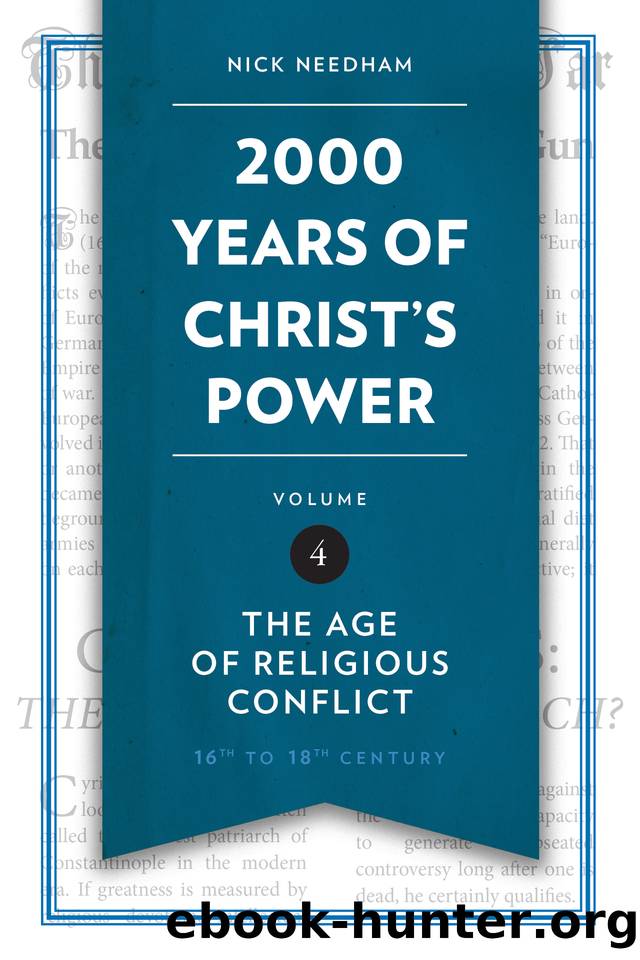2,000 Years of Christ's Power Vol. 4: The Age of Religious Conflict by Needham Nick

Author:Needham, Nick
Language: eng
Format: epub
Publisher: Christian Focus Publications
Published: 2016-10-26T00:00:00+00:00
2
James II and the Glorious Revolution
1. A new Catholic king
When James II (born 1633; reigned 1685â88) succeeded to the throne in February 1685, all seemed fair. The Whigs who had tried to exclude him from the monarchy had been smashed by Charles II; meanwhile Jamesâ allies, the Tories, had made âpassive obedienceâ a first article in their creedâit was never right to resist a lawfully crowned king. The only possible problem was that Tories were ardently Anglican, whereas James was Roman Catholic. Thus far, however, he had played his cards well, never criticizing the Church of England, but praising it for its loyalty to him. He was crowned according to a traditional Anglican ceremony, and he publicly promised to respect and maintain the Anglican Church, disavowing any intent to re-Catholicize England. If that relationship between monarch and Church ever broke down, James would be in trouble. Within three years, it was irreparably broken, and Tories joined with Whigs in ejecting James from the throne.
2. The Monmouth Rebellion and its aftermath
James reassured the country that he was no tyrant by holding a general election. The resulting parliament, which met in May 1685, was Tory-dominated, owing to the way Charles II had stripped towns and cities of their right to elect anyone as MP without royal consent. The Tory MPs were as loyal as James could have wished. They voted him for life the total income Charles had enjoyed.
But there was always going to be some opposition to James; the more fiercely Protestant sections of the population did not believe his moderate pose, and would be only too glad to see James fall. Only a month after parliament met, a violent popular rebellion broke out in the south-western counties (Devon, Dorset, Somerset). It was led by James Scott, Duke of Monmouth (1649â85), an illegitimate son of Charles II. Monmouth, a Protestant, had been the Whigsâ favoured candidate for the throne in the Exclusion Crisis of 1679â81, and had then been implicated in the extreme Whigsâ Rye House Plot in 1683. He was now living in exile in the Dutch Republic.
Monmouth gambled that the strongly Protestant, indeed Nonconformist, people of the south-western counties would back his claim to the throne, and rise up against James, if he (Monmouth) only showed his face and waved the flag of Protestant revolt against a popish king. Many lower class Nonconformists did indeed rally to Monmouth when he landed at Lyme Regis in Dorset on June 11th, but none of the Protestant gentry or nobility would support his hare-brained scheme. Monmouthâs ragtag army was butchered by Jamesâ professional forces at Sedgemoor in Somerset, on July 6th. Monmouth himself fled but was captured and executed only a week later.
The aftermath of the Monmouth Rebellion was harrowing for Nonconformists. James put judge George Jeffreys (1654â89) in charge of the trials of those taken prisoner during and after the uprising. Jeffreysâ conduct was fierce in the extreme; some 320 people were executed by hanging, and a further 800 or 900 shipped out as slave labour to the Caribbean plantations.
Download
This site does not store any files on its server. We only index and link to content provided by other sites. Please contact the content providers to delete copyright contents if any and email us, we'll remove relevant links or contents immediately.
What Is the Gospel? (Foreword by D. A. Carson) by Greg Gilbert(970)
Daily Strength: Devotions for Bible Believing Study by Douglas Stauffer & Andrew Ray & Rick Quatro(878)
Jesus in Me by Anne Graham Lotz(848)
Christian Ethics by Wilkens Steve;(824)
The Practice Is the Path by Tias Little(797)
New Morning Mercies by Tripp Paul David(780)
Veritas: A Harvard Professor, a Con Man and the Gospel of Jesus's Wife by Ariel Sabar(711)
Cleaning Up Your Mental Mess by Dr. Caroline Leaf(707)
Greatest Mystery in the World by Og Mandino(629)
The Creative Call by Janice Elsheimer(568)
No More Christian Nice Guy by Paul Coughlin(556)
Our Appointment with Life by Thich Nhat Hanh(552)
2084 by John C. Lennox(536)
Monastic Archaeology by Unknown(528)
This One Wild and Precious Life by Sarah Wilson(518)
Jesus--Awesome Power, Awesome Love (Discover 4 Yourself® Inductive Bible Studies for Kids) by Kay Arthur(512)
The Duties of Parents by J.C. Ryle(487)
The Tale of the Tardy Oxcart (Swindoll Leadership Library) by Swindoll Charles R(469)
A Closer Talk with God: Scriptural Prayers for Women by Kim Trujillo(458)
